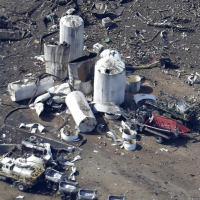No Accurate Records Kept of Serious Chemical Accidents in U.S.
 West Texas Fertilizer Explosion (photo: Tony Gutierrez, AP)
West Texas Fertilizer Explosion (photo: Tony Gutierrez, AP)
Following the horrific explosion in West, Texas, earlier this year, the Dallas Morning News wanted to find out how many serious chemical accidents had occurred in the United States. The newspaper combed through 750,000 federal records, only to learn that no single agency in the federal government has been keeping track of such disasters, and that whatever information agencies provide is likely to be 90% inaccurate.
“In fact, no one at any level of government knows how often serious chemical accidents occur each year in the United States,” Jon McClure, Daniel Lathrop and Matt Jacob reported for the Dallas Morning News. “And there is no plan in place for federal agencies to gather more accurate information.”
The investigation did uncover at least two dozen industrial chemical accidents over a span of four years in Texas that resulted in deaths, injuries or evacuations. But the newspaper couldn’t be certain it had found all the accidents that took place during that time.
It was determined that one federal agency—the U.S. Coast Guard’s National Response Center (NRC)—gathers comprehensive information on chemical accidents from around the U.S.
“But the NRC data is no more than a call log, like a 911 hotline for environmental emergencies, and first reports often turn out to be wrong,” according to the newspaper.
Unfortunately, some media outlets have used the data in their stories, which has only served to misinform the public.
The New York Times used the response center’s data for a June 1 editorial about the West explosion and the dangers of chemical accidents facing the nation. The editorial said that 1,270 people had died last year as a result of chemical spills and accidents around the country.
“But that figure included 907 deaths that didn’t involve chemicals and 137 [deaths] that never happened. They were recorded as a part of training exercises,” the Dallas Morning News found.
Had more complete and accurate data been compiled about the 2009 El Dorado Chemical Company fire, it could have prevented the explosion four years later at the West fertilizer plant. Like West, the El Dorado facility housed large amounts of ammonium nitrate. The fire burned out before reaching the chemical and setting off an explosion. But that information was not included in the NRC database, which only described the event as a “large chemical fire,” said the News.
Government reports calling attention to the lack of chemical accident data go back to the 1980s. The Environmental Protection Agency attempted to establish such a database in 1985, but within four years it lost its funding. The National Toxic Substances Incident Program gathers this data from state and local agencies, but it has lacked funding to establish a fully inclusive national resource.
A self-reporting program sponsored by the chemical industry was set up by 100 members of the American Chemistry Council, but it lacks credibility due to the opposition of many companies to release their accident data.
-Noel Brinkerhoff, Danny Biederman
To Learn More:
After West Disaster, News Study Finds U.S. Chemical Safety Data Wrong about 90 Percent (by Jon McClure, Daniel Lathrop and Matt Jacob, Dallas Morning News)
The West Texas Fertilizer Plant Explosion Was Not a Freak Event (by Roddy Scheer and Doug Moss, Scientific American)
Ammonium Nitrate: Dangerous Substance not Included in EPA List of Dangerous Substances (by Noel Brinkerhoff, AllGov)
- Top Stories
- Unusual News
- Where is the Money Going?
- Controversies
- U.S. and the World
- Appointments and Resignations
- Latest News
- Musk and Trump Fire Members of Congress
- Trump Calls for Violent Street Demonstrations Against Himself
- Trump Changes Name of Republican Party
- The 2024 Election By the Numbers
- Bashar al-Assad—The Fall of a Rabid AntiSemite






Comments